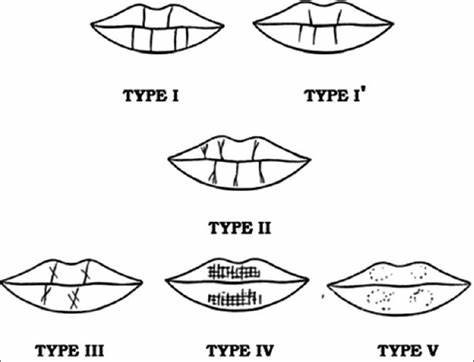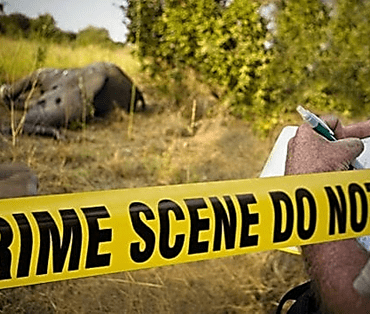INTRODUCTION
Cheiloscopy is an investigative technique that makes use of lip impressions to identify individuals. Lip prints, like fingerprints, are distinctive to each person and can be used to identify them in forensic investigations.
Lip prints are made of unique wrinkles, grooves, and lines on the lips, and these patterns are divided into multiple types based on their shape and size. Lip prints are categorized in the same way that fingerprints have been, with different patterns allocated to each type. Lip prints can be extremely helpful for linking a person to a crime scene.
CLASSIFICATION OF LIP PRINTS
Suzuki and Tsuchihash’s classification is the most regularly used and widely accepted.
Classification of lip prints can be classified as follows;
- Type I: clear-cut grooves running vertically across the lip.
- Type I’: straight grooves that disappear halfway instead of covering the entire lip.
- Type II: fork grooves in their course.
- Type III: grooves intersecting with each other.
- Type IV: reticulate grooves.
- Type V: undetermined.
Fig 1: Classification of Lip Prints (Suzuki and Tsuchihash’s classification)
Fig 2: Individual features of line pattern on the red part of lips by Kasprzak
THE UTILITY OF LIP PRINTS
- FOR SEX DETERMINATION- The sex of the individual is determined as:
-Type I and I’ patterns are dominant in females in the 3rd and 4th quadrants.
-Type II pattern is dominant in males in the second quadrant.
Individuals having different patterns in all quadrants is common in males and the same pattern in all quadrants is common in females.
Fig 3: Lip Prints quadrants
- FOR PERSONAL IDENTIFICATION- the specific grooves that are present in the human lip plays an important role in the identification of the individual. Each lip print is measured for its length, further divided into six equal parts:
- Upper right
- Upper middle
- Upper left
- Lower left
- Lower middle
- Lower right
Fig 4: Division of Lip prints
Some examples showing lip print classification are mentioned below:
Fig 5: Lip print showing Type I grooves in third and fourth quadrants medially
Fig 6: Lip print Type V grooves in 3rd and 4th quadrants
Fig 7: Lip print showing Type II grooves in 3rd and 4th quadrants
Fig 8: Lip print showing Type III grooves in 1st and 2nd quadrants
Fig 9: Lip print showing Type III grooves in 1st and 2nd quadrants
LIP PRINTS ON CRIME SCENE
The following are the different types of lip prints observed on crime scenes:
- VISIBLE PRINTS: These types of lip prints are visible to the naked eye and do not require further development for visualization.
- LATERAL PRINTS: These types of lip prints are not visible to the naked eye and require further development for visualization.
- 3-D or PLASTIC PRINTS: These kinds of lip prints are found on soft gel-like surfaces such as butter, wax, and so on. They are visible to the naked eye but may require extra development for photography.
RECORDING LIP PRINTS
To record Lip Prints using the magna brush method, the person should impress his or her lips against a glossy porous surface or a smooth nonporous surface.
- Photographing the suspect’s lips.
- On a non-porous flat surface such as a mirror they can be photographed, enlarged, and overlay tracings made of the grooves.
- Applying lipstick, lip rouge, or other suitable transfer mediums to the lips and then having the individual press his or her lips to a piece of paper or cellophane tape or similar surface.
- Use a finger printer, preferably a roller finger printer. The special paper rolled onto the roller finger printer was applied directly to the lips to record the pattern of the Lip Print. The Lip Prints obtained by these methods were traced onto cellophane paper and examined with a magnifying glass.
- By having the subject press his or her lips against a suitable surface (without lipstick or another recording medium) and then process these prints with either conventional fingerprint developing powder or a Magna brush and magnetic powder.
Fig 10: Lip prints using cellophane tape
Fig 11: Developed latent lip print using conventional white powder
DEVELOPMENT OF LIP PRINTS
The methods used to produce lip prints from diverse surfaces are similar to those used to develop fingerprints.
The powder method is commonly used to identify latent prints on non-porous surfaces such as glass, marble, metal, plastic, finished wood, and so on.
When the powder is applied on non-porous surfaces, it sticks to the residue, allowing investigators to locate the print.
Different powders are used to develop lip prints:
- Aluminium powder method
- Magnetic powder method
- Plumb carbonate method (white powder)
Following are the chemical methods that are used to develop the lip prints
- Iodine fuming method: must be photographed quickly as print fades away.
- Silver nitrate method: impressions in cardboard and paper-like surfaces.
- Ninhydrin method: reacts with oils in the prints to create a purple print, similar to the fingerprints.
Lead powder is distributed in the area having lip print with the help of a brush, then the area should be X-rayed and photographic film of X-Ray should be treated with required chemicals.
- DEVELOPMENT OF LIP PRINT IN MULTI-COLOURED SURFACE:
-Sudan black reagent-it can apply directly to the film
-Yellow fluorescent powder
-Nile red reagent.
When the efficiency of various fingerprint powders and reagents on lipstick prints was researched, it was found that red (Dragon’s Red), fingerprint black, and silver metallic powders were the most effective. It was also discovered that sublimated iodine has no effect on development.
LIFTING OF LIP PRINTS
- PHOTOGRAPHIC METHOD: The prints should always be photographed for further reference.
- TAPE LIFTING METHOD: Powdered dusted lip prints should be lifted with transparent tape.
ROLE OF LIP PRINTS IN FORENSIC INVESTIGATIONS
Lip prints can play a role in forensic investigations, although their significance is not as pronounced as fingerprints.
The lip prints are commonly found in cases of sexual assaults, burglaries, murders, rapes, etc. These prints gets deposited on the surfaces because of the moisturization done by the tongue and secretions of the minor salivary and sebaceous glands present on the vermilion surface of lips. Thus the latent prints should always be considered while investigating the crime scene and various objects such as glasses, bottles, cups, leftover fruits, cigarette butts, bed sheets, and cushions should be examined carefully.
The following are the aspects that can be determined using lip prints-
- Personal identification: The lip prints are unique to everyone and thus if found at the crime scene can play a significant role in the identification of the criminal.
- Race determination: On the basis of the thickness of lips, 4 groups can be identified: Thin lips (common in European Caucasoid), Medium lips (8 to 10 mm, are most commonly found), Thick lips (generally found in Negroid), Mix lips (commonly found in Orientals)
- Sex determination
Case studies where lip prints proved to be useful
- In 1966 in Poland, cheiloscopy proved to be helpful in solving the case of burglary. The analysis by experts was done and it was found that the lip impression found on the crime scene did not match with the suspect and thus helped in proceeding further in the investigation.
- In 1970, an extremely rare case was reported where it was analyzed that the lip prints found on the envelope did not belong to the suspects.
- In 1988, a burglary case in a grocery store was solved due to the lip prints found. Lip prints were found along with the tooth marks on a piece of cake. The analysis revealed that the person who had left the trace was one of the burglars. The results of both tooth marks and lip prints supported the idea of the involvement of that burglar.
LIP PRINT AS EVIDENCE IN COURT
Lip prints are rarely used as evidence in court, and their acceptance is in doubt. Professor Jay Siegel (Professor of Forensic Science and Associate Director of the School of Criminal Justice, Michigan State Collection of Lip Prints Journal of Oral Health Research, Volume 1, Issue 4, December 2010 135 University) considers Lip Print evidence to be admissible in court. The FBI has only used lip prints as a positive identifying measure once.
LIMITATIONS/CHALLENGES OF LIP PRINTS
Though lip prints are valuable in forensic investigations, but also have several limitations:
- Lack of standardization: There is no standardized system for lip print classification. Thus making it difficult to compare and analyze them consistently.
- Variability: Lip prints can change over time due to certain factors like aging, facial expressions, or injuries, making them less stable than fingerprints.
- Surface dependency: The quality and visibility of lip prints are highly dependent on the surface on which they are found. Prints on porous or uneven surfaces may not be as clear or reliable.
- Influence of environmental factors: Humidity, temperature, and exposure to light can affect the preservation of lip prints at a crime scene.
- Limited databases: Unlike fingerprints and DNA, there is a lack of extensive lip print databases for comparison which hinders the accuracy of matching.
- Circumstantial evidence: Lip prints are typically considered circumstantial evidence (they are less conclusive than DNA or fingerprint evidence in court.
- Privacy concerns: Collecting lip prints without consent may raise privacy concerns, as they can reveal personal characteristics.
- Smudging and erosion: Lip prints are prone to smudging, erosion, or distortion which can occur naturally or during collection reducing their accuracy.
- Subjectivity: The interpretation of lip prints can be subjective relying on the expertise of the forensic examiner. The subjectivity can introduce potential bias.
- Non-uniform patterns: Unlike fingerprints, lip prints do not have a standardized classification system, which can make analysis and comparison more challenging.
- Resource intensive: The collection and analysis of lip prints can be resource-intensive and time-consuming which may not always be practical in certain forensic investigations.
Lip prints can be a useful tool in forensic investigations, but their limitations should be acknowledged. These challenges associated with lip prints make them less reliable and less frequently used in forensic investigations compared to established methods like fingerprint and DNA analysis. They are most effective when used in conjunction with other forensic evidence to build a more comprehensive case.
CONCLUSION
The possibilities for using the red area of the lips to identify an individual are greater than commonly thought. This type of trace can only be discovered when a perpetrator’s lips make direct, physical contact with an object at the site of the crime. Lip Prints, on the other hand, can now be used to identify potential suspects or to support evidence obtained in certain investigations.
The collection of visible and latent Lip Prints using adequate transferring and recording medium is critical for their consideration as positive evidence in forensic investigations.
As a result, one might conclude that identity can be established through a variety of methods, making the identification process virtually flawless.
REFERENCES:
REFERENCES:
- TY – JOUR AU – Ajit D., Dinkar AU – Prabhu, Rachana AU – Prabhu, Vishnudas PY – 2010/01/01 SP – 129 EP – 135 T1 – Collection of Lip prints as forensic evidence at the crime scene – An insight VL – 1 JO – Journal of Oral Health Research ER –
- Prabhu RV, Dinkar AD, Prabhu V, Rao PK. Cheiloscopy: revisited. Journal of Forensic Dental Sciences. 2012;4(1):47. doi:10.4103/0975-1475.99167
- Suzuki K, Tsuchihashi Y. A new attempt of personal identification by means of lip print. JADA. 1970;42:8–9. [PubMed] [Google Scholar]
- Venkatesh R, David MP. Cheiloscopy : An aid for personal identification. Journal of Forensic Dental Sciences. 2011;3(2):67. doi:10.4103/0975-1475.92147
- Sharma P, Saxena S, Rathod V. Cheiloscopy: The study of lip prints in sex identification. Journal of Forensic Odontology. 2009;1(1):24. doi:10.4103/0974-2948.50884
- Peter T, Chatra L, Ahsan A. Cheiloscopy. International Journal of Forensic Odontology. 2016;1(2):48. doi:10.4103/2542-5013.194272
- Castelló A, Alvarez‐Seguí M, Verdú F. Luminous lip-prints as criminal evidence. Forensic Science International. Published online December 1, 2005. doi:10.1016/j.forsciint.2004.12.005
- Castello A. Long-lasting lipsticks and latent prints. Document – Gale Academic OneFile. Published April 1, 2002. https://go.gale.com/ps/i.do?id=GALE%7CA137969091&sid=googleScholar&v=2.1&it=r&linkaccess=abs&issn=15288005&p=AONE&sw=w&userGroupName=anon%7Ebc2b9cdb&aty=open-web-entry
- Kasprzak J. Possibilities of cheiloscopy. Forensic Science International. 1990;46(1-2):145-151. doi:10.1016/0379-0738(90)90154-q
- New attempt of personal identification by means of lip print. PubMed. Published January 1, 1970. https://pubmed.ncbi.nlm.nih.gov/5269498/

















Post comments (0)